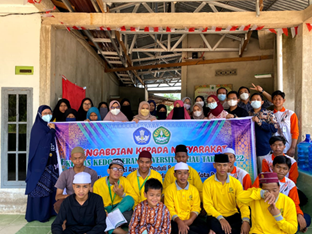Pemberdayaan Masyarakat dalam Pencegahan Gangguan Gizi Anak dalam Hubungannya dengan Cacingan di Panti Asuhan Kota Dumai Community Empowerment in the Prevention of Child Nutrition Problems in Relationship with Helminth Infestation in Orphanages Dumai City
Main Article Content
Abstract
Malnutrition is a significant health problem in Indonesia today and is one of the highlights of government programs in the health sector. Nutritional status has a vital role in the growth and development of children and is also closely related to intelligence. Soil-Transmitted Helminths (STH) infestation is a chronic disease that impacts nutritional disorders. One of the community groups that need to be considered in nutritional problems and their relation to intestinal worms is an orphanage. This activity aims to increase community empowerment through education about nutrition and its disorders, STH infestation, and its impact on growth and development. In addition, the nutritional status of the children living in the orphanage will be checked. This activity found that most of the orphanage residents had a low level of knowledge about nutritional disorders and worm infestations, 48.84%. The results of the nutritional status examination showed that most of the orphanage residents had normal nutritional status, but 21.15% were still undernourished.
Downloads
Article Details

This work is licensed under a Creative Commons Attribution-ShareAlike 4.0 International License.
Authors who publish with this journal agree to the following terms:
- Any article on the copyright is retained by the author(s).
- Author grant the journal, right of first publication with the work simultaneously licensed under a Creative Commons Attribution License that allows others to share work with acknowledgment of the work authors and initial publications in this journal.
- Authors are able to enter into a separate, additional contractual arrangements for non-exclusive distribution of published articles of work (eg, post-institutional repository) or publish it in a book, with acknowledgment of its initial publication in this journal.
- Authors are permitted and encouraged to post their work online (e.g., in institutional repositories or on their websites) prior to and during the submission process, as can lead to productive exchanges, as well as earlier and greater citation of published work.
- The article and any associated published material is distributed under the Creative Commons Attribution-ShareAlike 4.0 International License
References
Al Amin, A. S. M. & Wadhwa, R. (2022). Helminthiasis. Treasure Island: StatPearls.
Aryu, C. (2020). Epidemiologi Stunting. Semarang: Fakultas Kedokteran Universitas Diponegoro.
Centers for Disease Control and Prevention. (2013). Parasites - Soil-transmitted helminths. https://www.cdc.gov/parasites/sth/index.html
Centers for Disease Control and Prevention. (2022). Introduction of Epidemiology. https://www.cdc.gov/training/publichealth101/epidemiology.html
Gandahusada, S., Illahude, H. D., & Pribadi, W. (2004). Parasitologi Kedokteran. Jakarta: Fakultas Kedokteran Universitas Indonesia.
Garcia, L. S. (2016) Diagnostic Medical Parasitology. Washington DC: ASM Press. https://dx.doi.org/10.1128/9781555819002
Kementerian Kesehatan Republik Indonesia. (2021). Penurunan Prevalensi Stunting Tahun 2021 Sebagai Modal Menuju Generasi Emas Indonesia Tahun 2045. https://sehatnegeriku.kemkes.go.id/baca/umum/20211227/4339063/penurunan-prevalensi-stunting-tahun-2021-sebagai-modal-menuju-generasi-emas-indonesia-2045/
Maryanti, E. Wahyuni, D., Ernalia, Y., Haslinda, L., & Lesmana, S. D. (2017). Hubungan Enterobiasis dengan Status Gizi pada Anak di Dua Panti Asuhan Pekanbaru. Jurnal Kesehatan Melayu, 1(1), 1-4. https://doi.org/10.26891/jkm.v1i1.2017.1-4
Mekonnen, Z., Hassen, D., Debalke, S., Tiruneh, A., Asres, Y., Chelkeba, L., et al. (2020). Soil-transmitted helminth infections and nutritional status of school children in government elementary schools in Jimma Town, Southwestern Ethiopia. SAGE Open Medicine, 8, 205031212095469. https://doi.org/10.1177/2050312120954696
Noprianty, R., Sukmawati, I. K., Shandi, S. I., Lengga, V. M., & Adianti, R. Q. (2023). Upaya Peningkatan Pengetahuan, Sikap dan Perilaku dengan Kejadian Muntaber melalui Perilaku Hidup Bersih dan Sehat. PengabdianMu: Jurnal Ilmiah Pengabdian Kepada Masyarakat, 8(1), 34–40. https://doi.org/10.33084/pengabdianmu.v8i1.4115
Northstone, K., Joinson, C., Emmett, P., Ness, A., & Paus, T. (2012). Are dietary patterns in childhood associated with IQ at 8 years of age? A population-based cohort study. Journal of Epidemiology and Community Health, 66(7), 624–628. https://doi.org/10.1136/jech.2010.111955
Noviastuti, A. R. (2015). Infeksi Soil Transmitted Helminths. Medical Journal of Lampung University, 4(8), 107-116.
Nur, A. I. (2011). Hubungan Perilaku Higiene dan Status Gizi dengan Infestasi Soil Transmitted Helminths pada Murid SDN 008 Sukaping Kecamatan Pangean Kabupaten Kuantan Singingi. Skripsi. Pekanbaru: Universitas Riau.
Rozi, F. (2022). Kota Dumai Optimis Mampu Turunkan Angka Stunting. https://lamanriau.com/2022/05/19/kota-dumai-optimis-mampu-turunkan-angka-stunting/
Siregar, C. D. (2016). Pengaruh Infeksi Cacing Usus yang Ditularkan Melalui Tanah pada Pertumbuhan Fisik Anak Usia Sekolah Dasar. Sari Pediatri, 8(2), 112-117. https://dx.doi.org/10.14238/sp8.2.2006.112-7
Suchdev, P. S., Davis, S. M., Bartoces, M., Ruth, L. J., Worrell, C. M., Kanyi, H., et al. (2014). Soil-transmitted helminth infection and nutritional status among urban slum children in Kenya. American Journal of Tropical Medicine and Hygiene, 90(2), 299–305. https://doi.org/10.4269/ajtmh.13-0560
UNICEF Indonesia. (2018). Gizi: Mengatasi Beban Ganda Malnutrisi di Indonesia. https://www.unicef.org/indonesia/id/gizi?gclid=CjwKCAjwu4WoBhBkEiwAojNdXq39Qs2rrwVzyExN3Twakx40kfdP68QLt7E5Dk05oPM0GdQsw5-RWxoCiP8QAvD_BwE
World Health Organization. (2023). Soil-transmitted helminth infections. https://www.who.int/news-room/fact-sheets/detail/soil-transmitted-helminth-infections
